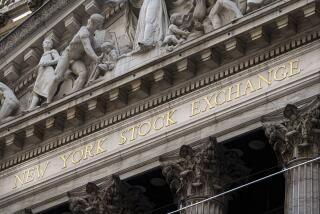The Action Again Is Overseas as Foreign Markets Bounce Back
- Share via
After a gut-wrenching spring plunge, many foreign stock markets have returned to a familiar pattern: They’re sharply outpacing the U.S. market.
Hong Kong’s main stock index, the Hang Seng, hit a six-year high last week. India’s Sensex index has rebounded 27% since mid-June, and the French market’s CAC index has risen 9.3% in the same period.
By contrast, the U.S. Standard & Poor’s 500 index has inched up 3.6% from its mid-June low.
Analysts say the snapback overseas, while many U.S. stocks tread water, is a barometer of global investors’ expectations for economic and corporate profit growth in the foreseeable future.
With U.S. economic growth showing signs of slowing, as evidenced by the Federal Reserve’s decision to pause last week in its credit-tightening campaign, some investors are betting that they can find hotter stock prospects abroad.
“In Asia, in particular, people are focusing on growth in their own economies,” said Clark Winter, global investment strategist for Citigroup Private Bank in New York.
Fear of rising interest rates had been a key trigger of the mid-May to mid-June dive in stocks worldwide. Even though rates are expected to continue rising in many countries overseas, investors appear to be less worried now that higher rates could choke off growth abroad.
Japan’s central bank began to tighten credit in July after years of holding short-term interest rates near zero. Yet commercial bank lending rose in July at the fastest pace in more than five years, the Bank of Japan said last week.
Although Japan’s Nikkei stock index is down 1.6% year to date, it has jumped 11.5% since mid-June and on Monday reached its highest level since May 30.
In Europe, major stock markets have held on to their summer gains even though the European Central Bank raised its benchmark interest rate to 3% from 2.75% on Aug. 3 and hinted that another increase might come in the fall if the region’s economic expansion remained on track.
The hunt for growth also has brought investors back to markets of emerging economies such as India, Mexico and Russia, many of which have generated spectacular stock returns since 2000.
U.S.- and Europe-based mutual funds that invest in emerging markets had a net cash inflow of $373 million in the seven days ended Wednesday, according to Emerging Portfolio Fund Research in Cambridge, Mass. That’s the largest weekly inflow since mid-May, just before stock prices began to tumble, said Cameron Brandt, global markets analyst at the firm. The funds tracked by Emerging Portfolio Fund Research have total assets of $122 billion.
Although the spring dive in emerging markets was dramatic -- the Russian market, for example, dropped 30% from May 6 to June 13 -- a pullback had been widely expected because of the wild run-ups in many of those markets from January to April.
Instead of frightening foreign investors away, the sell-off in emerging markets came as a relief to many potential buyers of those stocks, Brandt said.
“Quite a bit of money has just been waiting for a decent entry point,” he said.
Arthur Micheletti, investment strategist at financial advisory firm Bailard Inc. in Foster City, Calif., said his firm in July boosted the weighting of foreign stocks in its portfolios by 25%, attracted by lower prices.
One factor in that decision, Micheletti said, was the firm’s expectation that the dollar would weaken again if the Federal Reserve kept short-term interest rates level while central banks in Europe, Japan and elsewhere continued to tighten credit because of stronger growth.
The dollar’s slide since 2001 -- and again this year against many currencies -- has juiced U.S. investors’ gains in foreign stocks.
If the euro currency rises in value against the dollar, for example, stocks denominated in euros are worth more when translated into dollars, even if the share prices are unchanged.
Year to date, the German stock market is up 5.2% in euros. But in dollars, the German market is up 13.1%.
Currencies can cut both ways, however: The dollar’s strength against the Mexican peso this year has hurt U.S. investors’ returns on Mexican stocks.
James Berliner, chief investment officer at Westmount Asset Management in Century City, said he was downbeat on the dollar’s long-term prospects, given the nation’s large trade and budget deficits. Many economists say the only way to fix the trade deficit, in particular, would be for the U.S. to allow the dollar to continue to slide.
But Berliner said the best reason to stick with foreign stocks was for basic diversification rather than as a currency bet. With the rise of China, India, Brazil and other up-and-coming economies, “capital will ultimately follow growth,” he said.
Berliner said his firm’s typical client stock portfolio was 30% in foreign shares and 70% in U.S. shares.
Many U.S. financial advisors have been raising their holdings of foreign stocks in recent years, and some say they expect to continue to do so.
“I see us probably increasing our international allocation over the long term,” said Giles Almond, head of financial advisory firm Matrix Wealth Advisors in Charlotte, N.C.
His clients typically have 15% to 30% of their stock holdings in foreign issues, up from 10% to 20% five years ago, Almond said. To invest overseas, he uses stock mutual funds such as the Artisan International fund and the First Eagle Overseas fund, he said.
Despite the volatility associated with foreign-stock investing, a significant bet on overseas markets offers the best way to participate in strong economic growth outside the U.S., Almond said.
Some of that growth, he said, may come directly at the expense of the U.S. economy and U.S. stocks, as foreign competitors gain more power and stature. “There have been many, many benefits of globalization, but one of the things it’s going to do is expose more of our weaknesses,” Almond said.
*
(BEGIN TEXT OF INFOBOX)
Foreign vs. domestic
Most categories of foreign stock mutual funds are beating U.S. funds’ returns in 2006, continuing the trend of recent years. Many foreign funds are being helped by the weaker dollar.
*--* Stock fund category Year-to-date total return* Latin America +16.6% Europe +14.0 Diversified emerging markets +10.2 Foreign large-cap value +10.2 Foreign large-cap growth +7.5 U.S. large-cap value +5.1 Diversified Asia/Pacific +5.0 U.S. small-cap value +1.9 U.S. small-cap growth -4.0 Japan -6.7 Avg. foreign fund +8.7 Avg. U.S. fund +0.4
*--*
*Through Friday
Source: Morningstar Inc.
More to Read
Inside the business of entertainment
The Wide Shot brings you news, analysis and insights on everything from streaming wars to production — and what it all means for the future.
You may occasionally receive promotional content from the Los Angeles Times.










